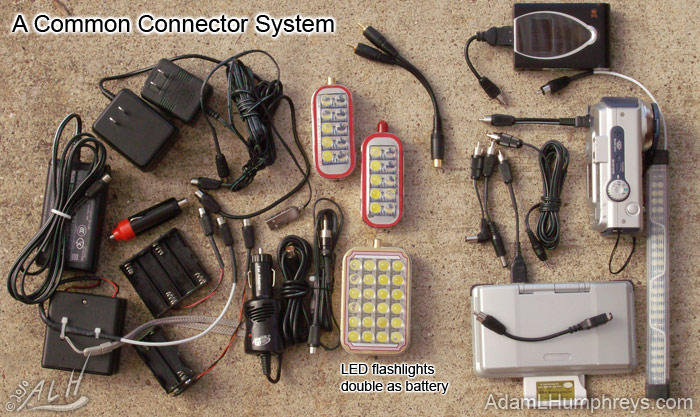Adding batteries to your devices
March 24, 2010
Archive
Archive
Whether you’re on vacation taking pictures and video or working on your laptop in the park, extended battery life can be a big help. Maybe you’ve lost or had a cell phone charger die and wondered if you could use an old one of the same voltage if it had the same connector. Adding more battery power or adapting connectors gives you a lot of flexibility. If you do it yourself, you may find it’s very inexpensive.
In-line RCA female jack connectors aren’t as common as male plugs, but they’re still inexpensive compared to other connectors. Here’s a few places to get them:

If the device uses a transformer, use a multimeter to measure the actual device’s power supply output voltage when it’s connected to the device. A transformers’ output voltage is usually higher when disconnected while the specified output can be lower.
NiMH (and NiCd) battery cells (a single AAA, AA, C, D, etc.) are 1.2V per cell (nominal voltage). When charged, the cells are 1.4V. (Li-ion cells are 3.6V nominal and 4.2V charged.) If your device uses 5V, then you would need 4 NiMH batteries in series for 4.8V (5.6V charged). Most laptops use 19.2V from their power supply, so that would be 16 NiMH batteries in series.
Develop a Common Connector System for Your Devices
Before you can add batteries to a device, you need to be able to connect them. I know “universal connectors” exist, but there are still plenty of devices that use special connectors. A simple solution is to splice into the cord and add RCA in-line connectors. I recommend using male plugs for the device connector and female jacks for the power source with a positive center and outer negative shield.In-line RCA female jack connectors aren’t as common as male plugs, but they’re still inexpensive compared to other connectors. Here’s a few places to get them:
- Alltronics: Audio Connectors
- Minute Man Electronics: Female In-Line RCA Jacks
- HomeTech Solutions: RCA Female In-Line Jack

Where can I get battery holders?
- BatterySpace.com: Battery Holders/ Racks
- Radio Shack (locally or online)
- Newark.com: Battery Holders
- Amazon.com: Battery Holders
How many batteries do I need?
If you match the capacity, Ah or mAh (milliamp hours), of the existing batteries with that of the added batteries, then you’ll nearly double its operating time. But, you can have as many milliamp hours as you want wiring batteries in parallel. The important thing to remember is to match the voltage of the device’s power supply.If the device uses a transformer, use a multimeter to measure the actual device’s power supply output voltage when it’s connected to the device. A transformers’ output voltage is usually higher when disconnected while the specified output can be lower.
NiMH (and NiCd) battery cells (a single AAA, AA, C, D, etc.) are 1.2V per cell (nominal voltage). When charged, the cells are 1.4V. (Li-ion cells are 3.6V nominal and 4.2V charged.) If your device uses 5V, then you would need 4 NiMH batteries in series for 4.8V (5.6V charged). Most laptops use 19.2V from their power supply, so that would be 16 NiMH batteries in series.
What battery type should I use?
If you plan to extend the battery life of a device, a good choice is NiMH because of its availability and flexibility. Nearly every battery pack used in today’s devices use one of three types of chemistries:- NiCd (Nickel Cadmium)
- NiMH (Nickel Metal Hydride)
- Li-ion/Li-polymer/LiFe (Lithium Ion/Polymer/Iron Phosphate)






